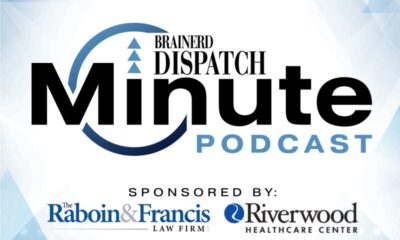Health
Tarlatamab Shows Promising Results in Small Cell Lung Cancer Trials

Results from a recent clinical trial indicate that tarlatamab, when combined with first-line chemoimmunotherapy, shows promising efficacy in treating patients with extensive-stage small cell lung cancer (ES-SCLC). This data was presented at the 2025 ESMO Congress and published simultaneously in The Lancet Oncology. The findings stem from the phase 1b DeLLphi-303 study, which aims to evaluate the potential of tarlatamab in this patient population.
At a median follow-up of 13.8 months, the objective response rate (ORR) for the treatment was observed at 71%, with a complete response rate of 5% and a partial response rate of 66%. Approximately 11% of participants experienced stable disease, while 8% had progressive disease, and 9% of responses were not evaluable. The median duration of response (DOR) reached 11.0 months, and the disease control rate was reported at 82%.
Lead study author Martin Wermke, MD, who is the director of the Trial Management/Early Clinical Trial Unit at the University Hospital Carl Gustav Carus Dresden, noted that the combination therapy demonstrated a manageable safety profile. “I hope I could convince you that the combination of another frontline chemoimmunotherapy that is PD-L1 targeting in the maintenance setting is safe and has a manageable toxicity profile,” Wermke stated during the oral presentation.
The study involved adult patients with ES-SCLC who had undergone one cycle of chemoimmunotherapy, consisting of platinum-etoposide and a PD-L1 inhibitor, irrespective of their response to the initial treatment. Participants were required to have measurable disease according to modified RECIST 1.1 criteria, with an Eastern Cooperative Oncology Group (ECOG) performance status of 0 or 1. Notably, individuals with treated and asymptomatic brain metastases were included.
The treatment regimen for the study comprised tarlatamab administered intravenously at 20 mg every three weeks, alongside platinum-etoposide and a PD-L1 inhibitor, such as atezolizumab or durvalumab. Patients continued this treatment until disease progression occurred.
Regarding safety, the median duration of treatment was 46 weeks, with three dose-limiting toxicities reported. All patients experienced treatment-related adverse events (TRAEs), with 43% classified as grade 3 and 35% as grade 4. Tragically, one patient succumbed to a TRAE attributed to sepsis related to the chemotherapy component.
The addition of tarlatamab to the existing chemoimmunotherapy demonstrated a safety profile that aligned with the individual agents’ profiles. Immune-related adverse events were reported in 2% of patients, excluding cytokine release syndrome (CRS) and immune effector cell-associated neurotoxicity syndrome (ICANS). Wermke emphasized that the combination does not exhibit additive or synergistic toxicity.
As the study progresses, further efficacy data is expected. The median progression-free survival (PFS) was reported at 10.3 months, with a 43.1% estimated 12-month PFS rate. Although the median overall survival (OS) is not yet estimable, the 12-month OS rate stands at 80.6%.
The trial was not designed to compare PD-L1 inhibitors, and no randomizations occurred between treatment arms. The baseline characteristics showed a median age of 63 years, with 67% of participants being male. Of the patients enrolled, 77% had extensive-stage disease, and a significant number had prior exposure to PD-L1 inhibitors.
Looking forward, Wermke concluded that these findings support further investigation of this tarlatamab regimen in a larger phase 3 trial, the DeLLphi-312 study. This upcoming research aims to validate the promising efficacy and safety outcomes observed in the current study.
-

 Health4 days ago
Health4 days agoRare Brain Condition Discovered More Common in New Mexico
-

 Politics5 days ago
Politics5 days agoPrince Andrew Steps Back from Royal Duties Following Epstein Memoir
-

 Sports5 days ago
Sports5 days agoMLS Decision Day 2025: Playoff Spots on the Line as Teams Clash
-

 Science5 days ago
Science5 days agoIdaho State University Launches Haunted Science Laboratory on Oct. 25
-

 World5 days ago
World5 days agoYoung Driver Dies in Collision with Box Truck in El Cajon
-

 Lifestyle5 days ago
Lifestyle5 days agoKent Hamilton Named Southeastern Farmer of the Year at Expo
-

 Health5 days ago
Health5 days agoRemembering Mary Ingleby: A Life of Love, Teaching, and Music
-

 Business5 days ago
Business5 days agoFirst National Bank of Groton’s Quiet Period Ends October 21
-

 Entertainment5 days ago
Entertainment5 days agoTrump Commutes George Santos’ Sentence, Sparks Controversy
-

 Politics5 days ago
Politics5 days agoNavy Veteran Max Quattromani Launches Campaign for Assessor Seat
-

 Sports5 days ago
Sports5 days agoSaquon Barkley Reacts to James Franklin’s Dismissal from Penn State
-

 Top Stories6 days ago
Top Stories6 days agoCommunity Gathers for Thrilling 25th Annual Chili Fest Today









